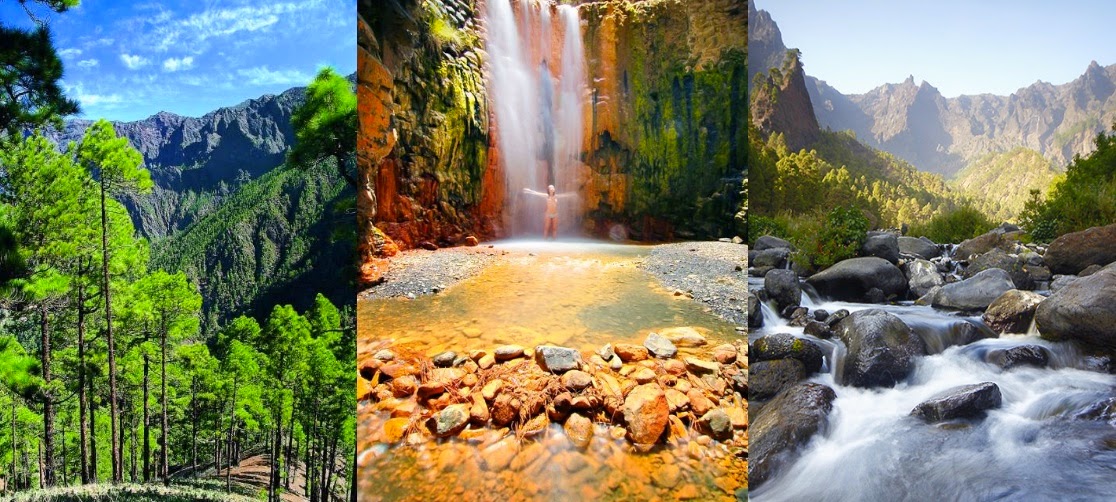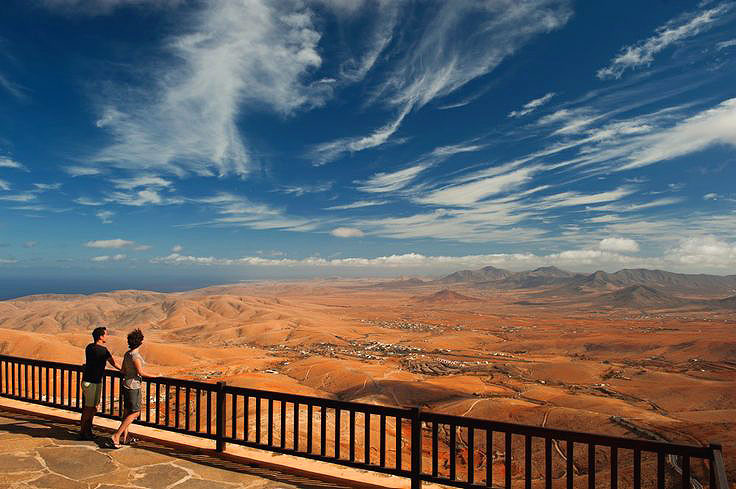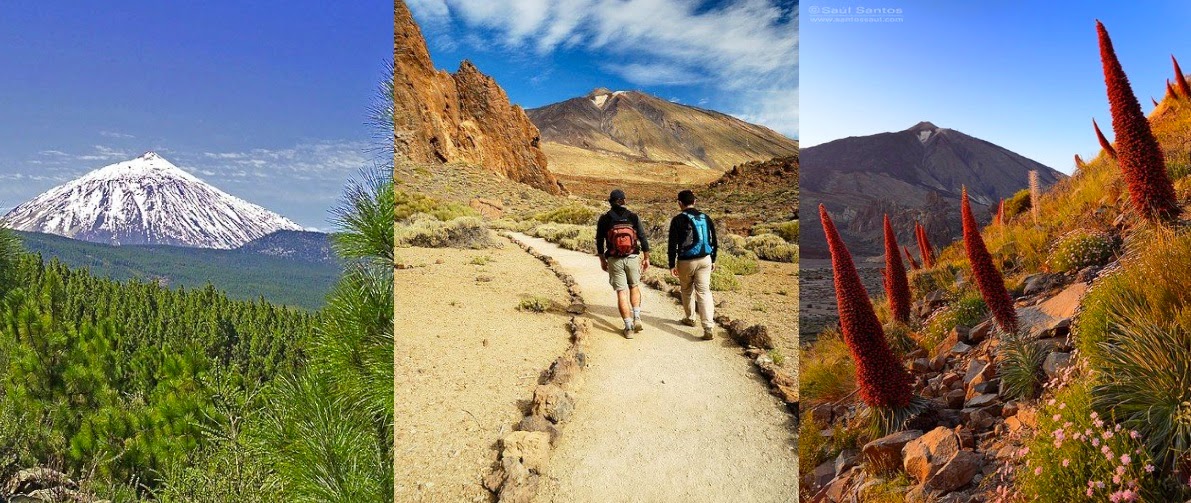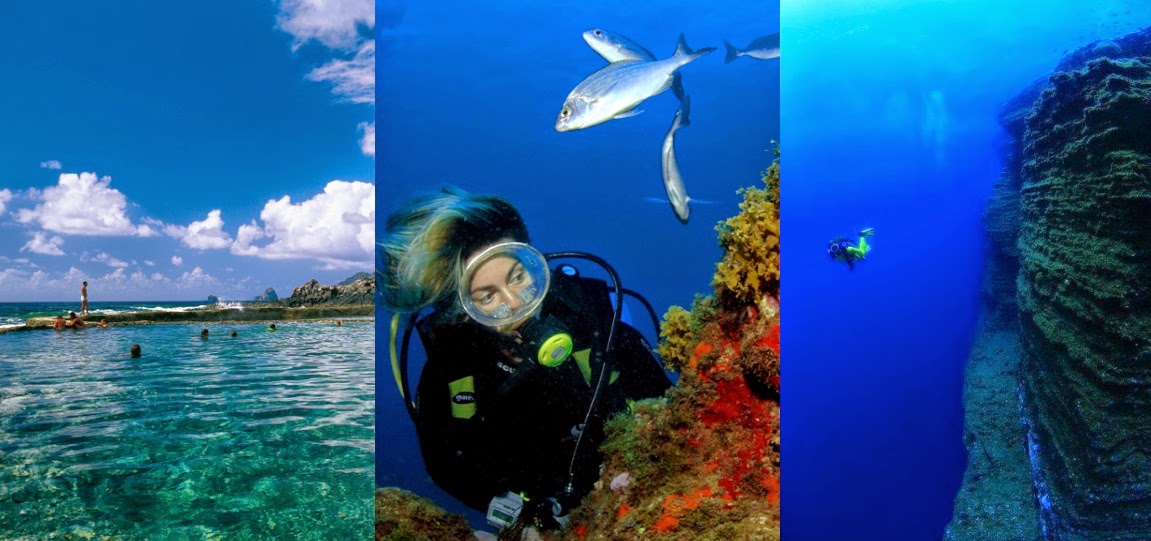1. LA PALMA – HIKING IN LA CALDERA DE TABURIENTE
In the heart of La Palma there is located the spectacular National Park “Parque Nacional de La Caldera de Taburiente”. The park is located in a crater-like depression of volcanic origin, which has a diameter of 8 kilometers. The steep and abrupt landscape has differences in altitude of nearly 2,000 meters. The highest point is the “Roque de Los Muchachos” with 2,426 meters, which also houses the observatory of La Palma. The beautiful landscape is dominated by the Canary Island pine (“pino canario”) and offers small streams and waterfalls. A hike in the “Caldera de Taburiente” is almost obligatory for any visitor of the island! There are different routes depending on how much time you have – a few hours, a day or even several days, because there is a possibility to camp in the National Park.
Im Herzen von La Palma befindet sich der spektakuläre Nationalpark “Parque Nacional de La Caldera de Taburiente”. Der Park befindet sich in einer kraterähnlichen Vertiefung vulkanischen Ursprungs, die einen Durchmesser von 8 Kilometer hat. Die steile und abrupte Landschaft kann Höhenunterschiede von fast 2.000 Metern aufweisen. Der höchste Punkt ist der “Roque de Los Muchachos” mit 2.426 Metern, wo sich auch das Observatorium von La Palma befindet. Die wunderschöne Landschaft wird von der kanarischen Pinie (“pino canario”) beherrscht und bietet kleine Bäche und Wasserfälle. Eine Wanderung in der “Caldera de Taburiente” ist ein absolutes Highlight! Es gibt verschiedene Routen je nachdem über wieviel Zeit man verfügt – einige Stunden, einen Tag oder sogar mehrere Tage, denn Sie können mit Genehmigung im Nationalpark campen.
En el corazón de La Palma se encuentra el espectacular Parque Nacional de La Caldera de Taburiente. El parque se encuentra en una depresión de origen volcánico, que tiene un diámetro de 8 kilómetros. El paisaje escarpado y abrupto dispone de variaciones de altitud de casi 2.000 metros. El punto más alto es el Roque de Los Muchachos con 2.426 metros, que también alberga el observatorio de La Palma. El bello paisaje está dominado por el pino canario y ofrece pequeños arroyos y cascadas. ¡Una caminata en la Caldera de Taburiente es casi obligatoria en sus vacaciones en La Palma! Hay diferentes rutas en función de la cantidad de tiempo del que dispone – de unas horas, un día o incluso varios días, ya que es posible acampar en el Parque Nacional después de obtener un permiso.
2. TENERIFE – A TRIP TO EL TEIDE
El Teide ist der höchste Berg Spaniens mit seinen 3.718 Metern und befindet sich im Nationalpark “Parque Nacional del Teide”. Der Teide ist vulkanischen Ursprungs und ist umgeben von einer wunderschönen Landschaft mit einer einzigartigen Natur und spektakulären Aussichtspunkten. Viele Pflanz- und Tierarten sind nur auf den Kanaren und einige nur auf dem Teide zu finden. Der große Stolz des Nationalparks ist die “Violeta del Teide”, eine violette Blume die auf einer Höhe von bis zu 3.500 Metern überleben kann. Verschiedene Wanderwege ermöglichen es die Landschaft zu genießen und eine Seilbahn befördert Besucher bis fast an die Spitze des Teides. Der Nationalpark verfügt auch über zwei Besucherzentren und einige Restaurants.
El Teide es la montaña más alta de España con sus 3.718 metros y está situado en el Parque Nacional del Teide. El Teide es de origen volcánico y está rodeado de un hermoso paisaje con una naturaleza espectacular y vistas únicas. Muchas especies de plantas y animales se encuentran sólo en las Islas Canarias y algunos sólo en el Teide. El gran orgullo del parque nacional es la “Violeta del Teide”, una flor púrpura que puede sobrevivir a una altitud de hasta 3.500 metros. Varios senderos permiten disfrutar del paisaje y un teleférico transporta a los visitantes casi hasta la cima del Teide. El Parque Nacional también cuenta con dos centros de visitantes y unos restaurantes.
El Teide is Spain’s highest mountain with 3,718 meters and is located in the national park “Parque Nacional del Teide”. The Teide is of volcanic origin and is surrounded by a beautiful landscape with a unique nature and spectacular viewpoints. Many plant and animal species are only found in the Canary Islands and some only on the Teide. The great pride of the national park is the “Violeta del Teide”, a purple flower that can survive at an altitude of up to 3,500 meters. Several hiking trails allow it to enjoy the scenery and a cable car transports visitors almost to the top of the Teide. The National Park also has two visitor centers and some restaurants.
3. GRAN CANARIA – GO FOR A WALK IN THE DESERT
Im Süden von Gran Canaria befinden sich die Dünen von Maspalomas, die einzige Landschaft dieser Art auf der Insel. Die Dünen beginnen am Strand “Playa del Inglés” und ein Teil von ihnen bewegt und verändert sich stetig, was eine sehr karge Vegetation mit sich bringt. Die Dünen von Maspalomas haben wie jede andere Wüste auch eine Oase, genannt “La Charca”, ein Teich in dem sich Salzwasser und Regenwasser vermischen und in dem auch einige Fische wohnen. Auch kleinere Büsche und Sträucher befinden sich in der Nähe von “La Charca” – ein Paradies für Vögel. Nach dem Besuch der “Sahara” von Gran Canaria können Sie an den nächstgelegenen Strand gehen oder an der Promenade mit Restaurants und Läden entlangspazieren.
En el sur de Gran Canaria se localizan las dunas de Maspalomas, un paisaje único en la isla. Las dunas comienzan en Playa del Inglés y una parte de ellas está en constante cambio y movimiento, lo que se traduce en una vegetación muy escasa. Las Dunas de Maspalomas también tienen un oasis, llamado “La Charca”, un lago donde el agua salada y el agua de la lluvia se mezclan y también hay algunos peces. Además en la cercanía de “La Charca” hay pequeños árboles y arbustos – un paraíso para las aves. Después de visitar el “Sahara” de Gran Canaria se puede ir a la playa cercana o pasear por el paseo marítimo con restaurantes y tiendas.
In the south of Gran Canaria there are located the dunes of Maspalomas, the only landscape of its kind on the island. The dunes start at the beach “Playa del Inglés” and a part of them is constantly moving and changing, which results in a very sparse vegetation. The Dunes of Maspalomas have an oasis, called “La Charca”, a pond where salt water and rain water is mixed and there also live some fishs. Even smaller bushes and shrubs are located near “La Charca” – a paradise for birds. After visiting the “Sahara” of Gran Canaria you can go to the beautiful beach “Playa del Inglés”, or stroll along the promenade with restaurants and shops.
4. LA GOMERA – TAKE A BOAT TOUR
La Gomera ist die perfekte Insel um Delphine und Wale zu beobachten, denn in den warmen Gewässern der Insel fühlen sich die Tiere besonders wohl. In den letzten Jahren wurden 23 verschiedene Arten von Delphinen und Walen in der Nähe der Insel gesichtet. Die häufigsten Delphinarten sind Tümmler, Rauzahndelfine, Streifendelfine und Gemeine Delfine. Auch der Kurzflossen-Grindwal und Cuvier-Schnabelwale wurden gesichtet. Ein Bootsausflug is aber auch ohne Delphine und Wale ein großartiges Erlebnis um die Schönheit des Meeres und der Küste von La Gomera zu bestaunen!
La Gomera es la isla perfecta para observar delfines y ballenas, debido a que las cálidas aguas de la isla atraen a los animales. En los últimos años, 23 especies diferentes de delfines y ballenas han sido avistadas en las proximidades de la isla. Las especies más comunes de los delfines son delfines mulares, delfines de dientes rugosos, el delfín listado y el delfín común. Incluso el calderón de aleta corta y ballenas picudas de Cuvier fueron avistados. Un viaje en barco es también una gran experiencia sin delfines y ballenas, ¡ya que se puede admirar la belleza del mar y de la costa de La Gomera!
La Gomera is the perfect island to watch dolphins and whales, because the warm waters of the island attract the animals. In recent years, 23 different species of dolphins and whales have been sighted in the proximity of the island. The most common species of dolphins are bottlenose dolphins, Rough-toothed dolphins, Striped dolphins and common dolphins. Even the short-finned pilot whale and Cuvier’s beaked whales were sighted. A boat trip is also a great experience without dolphins and whales, because you can admire the beauty of the sea and of the coast of La Gomera!
5. EL HIERRO – EXPLORE THE UNDERWATER WORLD
El Hierro ist die kleinste Insel der Kanaren, doch sie verfügt über eine beeindruckende Natur, die nicht nur an der Oberfläche sondern auch Unterwasser bewundert werden kann. Die einzigartige Biodiversität und das warme Klima der Kanaren machen die Küste von El Hierro zu einem Paradies für Taucher und Unterwasserfotografen. Schon wenige Meter vor der Küste kann man Tiefen von bis zu 200 Metern erreichen und die verschiedensten Tierarten beobachten. Die besten Punkte zum Tauchen sind “Los Corales”, “Roque de la Bonanza”, “La Caleta” und vor allem das Reservat “Punta de La Restinga”.
El Hierro es la isla más pequeña de las Islas Canarias, pero tiene una naturaleza impresionante, que se puede ver no sólo en la superficie sino también bajo el agua. La biodiversidad única y el clima cálido de las Islas Canarias hacen que la costa de El Hierro sea un paraíso para los buceadores y fotógrafos submarinos. A pocos metros de la costa se pueden alcanzar profundidades de hasta 200 metros y observar una gran variedad de especies animales. Los mejores lugares para el buceo son “Los Corales”, “Roque de la Bonanza”, “La Caleta” y sobre todo la reserva marítima de “Punta de La Restinga”.
El Hierro is the smallest island of the Canary Islands, but it has an impressive nature, which can be seen not only on the surface but also underwater. The unique biodiversity and the warm climate of the Canary Islands make the coast of El Hierro a paradise for divers and underwater photographers. Just a few meters off the coast you can reach depths of up to 200 meters and observe a big variety of animal species. The best spots for diving are “Los Corales”, “Roque de la Bonanza”, “La Caleta” and especially the area “Punta de La Restinga”.
6. FUERTEVENTURA – TRY SURFING
Fuerteventura hat einige der schönsten Strände der Kanaren – nicht nur zum Entspannen, sondern auch zum Surfen! Die Insel ist ein sehr beliebtes Reiseziel für Surfer, denn es gibt Wellen für alle Schwierigkeitsgrade und die Wassertemperatur liegt das ganze Jahr über zwischen 18 und 23º C. Ende September bis Ende März gibt es die besten Wellen, doch auch den Rest des Jahres ist Fuerteventura ein Surferparadies. Die Nordküste bietet World Class Wellen und die Ostküste und die Sandstrände sind perfekt für Anfänger. Es gibt unzählige Surfschulen, die auch das passende Equipment vermieten.
Fuerteventura tiene algunas de las mejores playas de Canarias – ¡no sólo para relajarse y disfrutar del sol, sino también para el surf! La isla es un destino muy popular entre los surfistas, ya que hay olas para todos los niveles de dificultad y la temperatura del agua durante todo el año se encuentra entre 18 y 23 °C. Desde finales de septiembre hasta finales de marzo hay las mejores olas, pero también el resto del año Fuerteventura es un paraíso para los surfistas. La costa norte ofrece olas World Class y la costa este y las playas de arena son perfectas para principiantes. Existen numerosas escuelas de surf que también alquilan el equipo adecuado.
Fuerteventura has some of the best beaches in the Canary islands – not only for relaxing and sunbathing, but also for surfing! The island is a very popular destination for surfers, because there are waves for all levels and the water temperature throughout the year is between 18 and 23 °C. From the end of September until the end of March there are the best waves, but also the rest of the year Fuerteventura is a surfer’s paradise. The north coast offers world class waves and the east coast and the sandy beaches are perfect for beginners. There are many surf schools that also rent equipment.
7. LANZAROTE – TAKE A CAMEL RIDE BETWEEN THE VOLCANOES
Die vulkanische Landschaft von Lanzarote ist atemberaubend. Drei Viertel von Lanzarote sind mit Lava bedeckt und ein Besuch des Nationalparks “Parque Nacional de Timanfaya” ist unverzichtbar für jeden Urlauber. Doch um die karge Landschaft mit ihren Lavaformationen richtig zu erleben, sollte man einen Ausflug auf einem Kamelrücken untenehmen. Das ist auch im “Parque Nacional de Timanfaya” möglich, wo man die Vulkankegel und die spärlichen Büsche und Flechten zwischen den Rot- und Brauntönen der Umgebung betrachten kann.
El paisaje volcánico de Lanzarote es impresionante. Tres cuartas partes de Lanzarote están cubiertas con lava y una visita al Parque Nacional de Timanfaya es obligatoria en unas vacaciones en la isla. Pero para poder experimentar sus formaciones de lava de forma adecuada, lo mejor es explorar la isla de los volcanes a lomos de un camello. Esto también es posible en el Parque Nacional de Timanfaya, donde se puede disfrutar de los conos volcánicos y de los escasos arbustos y líquenes entre los colores rojos y marrones del paisaje.
The volcanic landscape of Lanzarote is breathtaking. Three-quarters of Lanzarote are covered with lava and the national park “Parque Nacional de Timanfaya” is a must for any visit to the island. But to properly experience the landscape with its volcanic formations, you should take a trip on a camel’s back. This is also possible in the “Parque Nacional de Timanfaya”, where you can enjoy the volcanic cones and the sparse shrubs and lichens between the reds and browns of the landscape.
 |
| Enjoy the volcanic landscape on the back of a camel |





